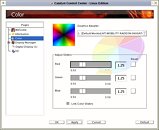Sunday, July 1st 2007

AMD updates Catalyst for Linux
Anyone who owns an AMD graphics card and runs it under Windows knows that driver updates are complete and frequent. However, change the operating system, and this level of support seems to evaporate. You're lucky to even get a LiveCD to boot if you have an ATI card in your system, and even if you manage to install a version of *nix, good luck getting 3D applications to run bug-free.
Thankfully, AMD decided to listen to their customers. The latest AMD Catalyst for Linux is much cleaner, much more efficient, and much faster than the older version of Catalyst. Classic *nix functions, such as switching between X server and CLI are much smoother/don't freeze the system, and late 3D applications (even simple ones such as Google Earth) actually work now, which couldn't be said for older versions of AMD Catalyst for Linux.
Granted, the Linux version is not as fully featured as the Windows version. However, it is just as functional, and just as stable, as the Windows version, which is a huge step in the right direction for *nix users.
Source:
The Inquirer
Thankfully, AMD decided to listen to their customers. The latest AMD Catalyst for Linux is much cleaner, much more efficient, and much faster than the older version of Catalyst. Classic *nix functions, such as switching between X server and CLI are much smoother/don't freeze the system, and late 3D applications (even simple ones such as Google Earth) actually work now, which couldn't be said for older versions of AMD Catalyst for Linux.
Granted, the Linux version is not as fully featured as the Windows version. However, it is just as functional, and just as stable, as the Windows version, which is a huge step in the right direction for *nix users.





18 Comments on AMD updates Catalyst for Linux
Or am I just misunderstanding your *nix?
The * could just be used to infer it includes everything xD
Technical minded people should know their recursive acronyms off by heart :P
There are many features to Linux that are more similar to Plan 9 than Unix.
Or if you mean the POSIX, then it applies equally to Windows. Windows is fully POSIX compliant, which is basically, what makes Linux close to Unix.
As for the logic of basic concepts, then that logic extends to incorporating Plan 9 as "basically Unix". Linux and Plan 9 share the "everything as a file" concept, which Unix only partially shares.
Edit: As for design philosophy, GNU and Unix are far, far apart for the most part when it comes to userland programs ;) One tool for one task is not the matra at the heart of developers of software for GNU ;)
Edit #2: As for the goal, the goal wasn't to create a Unix-like system, the reason it turned out Unix-like was because that's what worked well. Plan 9 worked better, hence Linux was changed (or evolved, as F/OSS software tends to do) into more of a Plan 9 - like system.
In my view, Unix-like != basically Unix. That's at the heart of our disagreement, I believe.
It doesn't have to contain the same source code to be "almost the same".
Behavior is essentially the same in a lot of cases...
A BMW is a car. A F1 car is a... car... while different, they both still scoot you along the road the same way ;D
I presume you can see my logic here, fallacious or not:
Antecedents:
If programs can be ported with little hassle between Unix "variations" then it's basically Unix
Windows is POSIX compliant
Linux is POSIX compliant
Consequents:
Windows is basically Unix
Windows is basically Linux
Linux and Unix are basically Windows
Edit:That analogy only serves to show that both Unix and Linux kernels, or operating systems depending on semantics.
To me, Unix, Linux, Mac OS X, and Windows are all just different operating systems, which all try to do the same thing: Make the computer do what the user wants it to do :). They just had different approaches to the same thing, work a bit differently, and do different things. I leave it at that and don't really care otherwise :p.